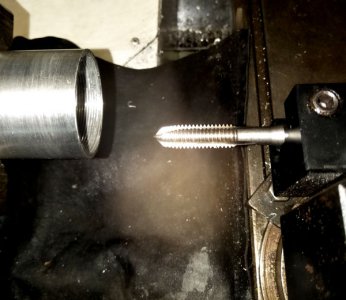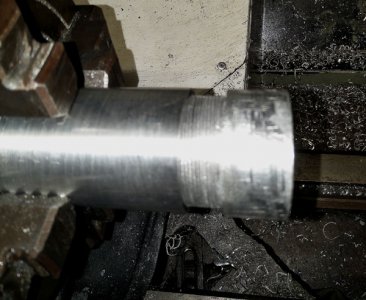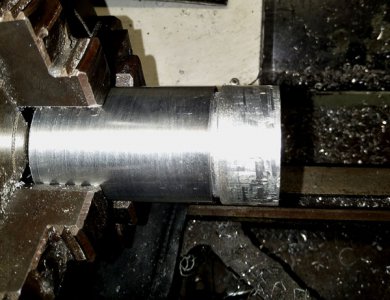- Joined
- Aug 22, 2012
- Messages
- 4,273
I havnt worked out how to do this with those weird imperial threads so I will leave that for someone more erudite in maths than myself to do so.
All the metric threads I cut on this lathe are done by leaving the half nuts engaged so the first attempt was done the same way.
I wanted a quad start 1mm thread.
I set the top slide parrallel to the ways, aligned the tool bit at 90 degrees to the work, set the change gears to give a 4mm thread pitch, ie four times the 1mm pitch of the actual thread.
(if I wanted a three start thread then I would choose a 3mm pitch)
I cut the first thread to the correct depth in about 5 passes (slow and easy) then reversed back pass the start and with the half nuts still engaged advanced the top slide 1mm and cut the second thread to the correct depth.
Repeat two more times and I had a quad start 1mm thread inside the tube.
The outside thread on the other tube was cut the same way.
It worked and they threaded together, but, it was rough feeling and only screwed in half way.
The small internal threading tool flexed as I got deeper in the hole and cut a slight taper.
So I wondered if a M1 threaded tap would make a better tool.
I set up the tap in the tool post with the leading edge of one set of flutes set at the centre line, pressed it into the existing threads to align it and tightened it up.

I re-cut the internal threads in the tube.
This time I only had to make the pass to the correct depth once as all four starts were cut at the same time.
4mm cut pitch meant that each quarter of a revolution started the next thread. Bingo, it worked.
Screwed together at the start

screwed together at the finish

sorry for the out of focus but I was too lazy to re take them
I also found this method of using the tap made it very easy to re-find the thread if the half nuts had to be disengaged for some reason.
A couple of caveats, be careful of distorting the thin walled tube by over tightening the chuck and use the largest dia tap of the required thread pitch as the first M6x1 flexed a bit but the M8x1 was fine.
I may make a mandrel for inside the tubing next time so it cannot distort.
All the metric threads I cut on this lathe are done by leaving the half nuts engaged so the first attempt was done the same way.
I wanted a quad start 1mm thread.
I set the top slide parrallel to the ways, aligned the tool bit at 90 degrees to the work, set the change gears to give a 4mm thread pitch, ie four times the 1mm pitch of the actual thread.
(if I wanted a three start thread then I would choose a 3mm pitch)
I cut the first thread to the correct depth in about 5 passes (slow and easy) then reversed back pass the start and with the half nuts still engaged advanced the top slide 1mm and cut the second thread to the correct depth.
Repeat two more times and I had a quad start 1mm thread inside the tube.
The outside thread on the other tube was cut the same way.
It worked and they threaded together, but, it was rough feeling and only screwed in half way.
The small internal threading tool flexed as I got deeper in the hole and cut a slight taper.
So I wondered if a M1 threaded tap would make a better tool.
I set up the tap in the tool post with the leading edge of one set of flutes set at the centre line, pressed it into the existing threads to align it and tightened it up.

I re-cut the internal threads in the tube.
This time I only had to make the pass to the correct depth once as all four starts were cut at the same time.
4mm cut pitch meant that each quarter of a revolution started the next thread. Bingo, it worked.
Screwed together at the start

screwed together at the finish

sorry for the out of focus but I was too lazy to re take them
I also found this method of using the tap made it very easy to re-find the thread if the half nuts had to be disengaged for some reason.
A couple of caveats, be careful of distorting the thin walled tube by over tightening the chuck and use the largest dia tap of the required thread pitch as the first M6x1 flexed a bit but the M8x1 was fine.
I may make a mandrel for inside the tubing next time so it cannot distort.
